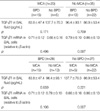1. Watterberg KL, Demers LM, Scott SM, Murphy S. Chorioamnionitis and early lung inflammation in infants in whom bronchopulmonary dysplasia develops. Pediatrics. 1996. 97:210–215.
2. Bry K, Lappalainen U, Hallman M. Intraamniotic interleukin-1 accelerates surfactant protein synthesis in fetal rabbit and improves lung stability after premature birth. J Clin Invest. 1997. 99:2992–2999.
3. Choi CW, Kim BI, Park JD, Koh YY, Choi JH, Choi JY. Risk factors for the different types of chronic lung disease of prematurity according to the preceding respiratory distress syndrome. Pediatr Int. 2005. 47:417–423.
4. Willet KE, Jobe AH, Ikegami M, Newnham J, Brennan S, Sly PD. Antenatal endotoxin and glucocorticoid effects on lung morphometry in preterm lambs. Pediatr Res. 2000. 48:782–788.

5. Bry K, Lappalainen U. Pathogenesis of bronchopulmonary dysplasia: the role of interleukin 1beta in the regulation of inflammation mediated pulmonary retinoic acid pathways in transgenic mice. Semin Perinatol. 2006. 30:121–128.
6. Husain NA, Siddiqui NH, Stocker JT. Pathology of arrested acinar development in postsurfactant bronchopulmonary dysplasia. Hum Pathol. 1998. 29:710–717.

7. Sakurai H, Nigam SK. Transforming growth factor-beta selectively inhibits branching morphogenesis but not tubulogenesis. Am J Physiol. 1997. 272(1 Pt 2):F139–F146.

8. Liu J, Tseu I, Wang J, Tanswell K, Post M. Transforming growth factor beta2, but not beta1 and beta3, is critical for early rat lung branching. Dev Dyn. 2000. 217:343–360.
9. Zhao J, Bu D, Lee M, Slavkin HC, Hall FL, Warburton D. Abrogation of transforming growth factor-beta type II receptor stimulates embryonic mouse lung branching morphogenesis in culture. Dev Biol. 1996. 180:242–257.
10. Zhao J, Lee M, Smith S, Warburton D. Abrogation of Smad3 and Smad2 or of Smad4 gene expression positively regulates murine embryonic lung branching morphogenesis in culture. Dev Biol. 1998. 194:182–195.

11. Zhao J, Shi W, Chen H, Warburton D. Smad7 and Smad6 differentially modulate transforming growth factor beta-induced inhibition of embryonic lung morphogenesis. J Biol Chem. 2000. 275:23992–23997.
12. Gauldie J, Galt T, Bonniaud P, Robbins C, Kelly M, Warburton D. Transfer of active form of transforming growth factor-beta 1 gene to newborn rat lung induces changes consistent with bronchopulmonary dysplasia. Am J Pathol. 2003. 163:2575–2584.
13. Vicencio AG, Lee CG, Cho SJ, Eickelberg O, Chuu Y, Haddad GG, Elias JA. Conditional overexpression of bioactive transforming growth factor-beta1 in neonatal mouse lung: a new model for bronchopulmonary dysplasia? Am J Respir Cell Mol Biol. 2004. 31:650–656.
14. Morris DG, Huang X, Kaminski N, Wang Y, Shapiro SD, Dolganov G, Glick A, Sheppard D. Loss of integrin alpha(v)beta6-mediated TGF-beta activation causes Mmp12-dependent emphysema. Nature. 2003. 422:169–173.
15. Bonniaud P, Kolb M, Galt T, Robertson J, Robbins C, Stampfli M, Lavery C, Margetts PJ, Roberts AB, Gauldie J. Smad3 null mice develop airspace enlargement and are resistant to TGF-beta-mediated pulmonary fibrosis. J Immunol. 2004. 173:2099–2108.
16. Kotecha S, Wangoo A, Silverman M, Shaw RJ. Increase in the concentration of transforming growth factor beta-1 in bronchoalveolar lavage fluid before development of chronic lung disease of prematurity. J Pediatr. 1996. 128:464–469.

17. Vicencio AG, Eickelberg O, Stankewich MC, Kashgarian M, Haddad GG. Regulation of TGF-beta ligand and receptor expression in neonatal rat lung exposed to chronic hypoxia. J Appl Physiol. 2002. 93:1123–1130.
18. Kattwinkel J. Textbook of neonatal resuscitation. 2006. 5th ed. Elk Grove Village: American Academy of Pediatrics and American Heart Association;1–42.
19. Kotecha S, Chan B, Azam N, Silverman M, Shaw RJ. Increase of interleukin-8 and soluble intercellular adhesion molecule-1 in bronchoalveolar lavage fluid from premature infants who develop chronic lung disease. Arch Dis Child Fetal Neonatal Ed. 1995. 72:F90–F96.
20. Salafia CM, Weigl C, Silberman L. The prevalence and distribution of acute placental inflammation in uncomplicated term pregnancies. Obstet Gynecol. 1989. 73:383–389.

21. Stocker JT. Srocker JT, Dehner LP, editors. The respiratory tract. Pediatric pathology. 1992. Philadelphia: JB Lippincott;533–541.
22. Anderson WR, Engel RR. Cardiopulmonary sequelae of reparative stages of bronchopulmonary dysplasia. Arch Pathol Lab Med. 1983. 107:603–608.
23. Hislop AA, Wigglesworth JS, Desai R, Aber V. The effects of preterm delivery and mechanical ventilation on human lung growth. Early Hum Dev. 1987. 15:147–164.

24. Gerdes JS, Yoder MC, Douglas SD, Paul M, Harris MC, Polin RA. Tracheal lavage and plasma fibronectin: relationship to respiratory distress syndrome and development of bronchopulmonary dysplasia. J Pediatr. 1986. 108:601–606.

25. Bruce MC, Wedig KE, Jentoft N, Martin RJ, Cheng PW, Boat TF, Fanaroff AA. Altered urinary excretion of elastin crosslinks in premature infants who develop bronchopulmonary dysplasia. Am Rev Respir Dis. 1985. 131:568–572.

26. Jobe AH, Bancalari E. Bronchopulmonary dysplasia. Am J Respir Crit Care Med. 2001. 163:1723–1729.

27. Charafeddine L, D'Angio CT, Phelps DL. Atypical chronic lung disease patterns in neonates. Pediatrics. 1999. 103:759–765.

28. Ueda K, Cho K, Matsuda T, Okajima S, Uchida M, Kobayashi Y, Minakami H, Kobayashi K. A rat model for arrest of alveolarization induced by antenatal endotoxin administration. Pediatr Res. 2006. 59:396–400.

29. Jonsson B, Tullus K, Brauner A, Lu Y, Noack G. Early increase of TNF alpha and IL-6 in tracheobronchial aspirate fluid indicator of subsequent chronic lung disease in preterm infants. Arch Dis Child Fetal Neonatal Ed. 1997. 77:F198–F201.
30. Kim BI, Lee HE, Choi CW, Jo HS, Choi EH, Koh YY, Choi JH. Increase in cord blood E-selectin and tracheal aspirate neutrophils at birth and the development of new bronchopulmonary dysplasia. J Perinat Med. 2004. 32:282–287.

31. Choi CW, Kim BI, Kim HS, Park JD, Choi JH, Son DW. Increase of interleukin-6 in tracheal aspirate at birth: a predictor of subsequent bronchopulmonary dysplasia in preterm infants. Acta Paediatr. 2006. 95:38–43.
32. Kunzmann S, Speer CP, Jobe AH, Kramer BW. Antenatal inflammation induced TGF-beta1 but suppressed CTGF in preterm lungs. Am J Physiol Lung Cell Mol Physiol. 2007. 292:L223–L231.
33. Kotecha S. Bronchoalveolar lavage of newborn infants. Pediatr Pulmonol Suppl. 1999. 18:122–124.

34. Grigg J, Arnon S, Silverman M. Fractional processing of sequential bronchoalveolar lavage fluid from intubated babies. Eur Respir J. 1992. 5:727–732.








 PDF
PDF ePub
ePub Citation
Citation Print
Print




 XML Download
XML Download